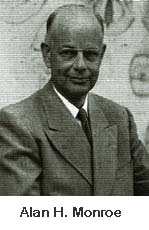Emotivative language (Alan Monroe)
The Motivated Sequences of Alan Monroe mean, that an audience can be motivated to respond affirmatively to a speaker's purpose. The speaker can achieve this by using the following steps of influence.

1. Attention
Gain the attention of the audience by
2. Need
Showing the importance and need for a change to the audience by
3. Satisfaction
Portraying plans and solutions to solve the problem by
The speaker needs to avoke the audience's desire to help to visualize the plan by
5. Action
Visualization needs to be translated into overt action by
Picture: http://igorristic.files.wordpress.com/2012/02/alanmonroe.jpg
Text: St. John, R. (2011). Retrieved January 27. 2011 at http://www.disciplewalk.com/files/Ron_st._John_monroe_sequence_Handout.pdf and based on exerpts and thoughts taken from: D.Ehinger, A.H. Monroe, and B.E. Gronbeck's, (1978) Principles and Types of Speech Communication, 8th. Ed., pp. 142-163; S.E. Lucas (1995) The Art of Public Speaking, 5th. Ed., pp. 353-361.
Gain the attention of the audience by
- relating to the audience
- showing the importance of the topic
- using quotations & anecdotes
- making starteling statements
- telling dramatic stories
- asking (rhetorical) questions
2. Need
Showing the importance and need for a change to the audience by
- Giving clear concise statements
- describing the need or opportunity
- offering statistical data
3. Satisfaction
Portraying plans and solutions to solve the problem by
- presenting actions and changes the audience should adopt
- explaning the whole plan in a simple way, which is easy to understand for everyone
- showing how this solution logically meets the problem
- giving examples how the plan worked effectively already
- using facts, figures and the testimony of experts
The speaker needs to avoke the audience's desire to help to visualize the plan by
- using the positive method
- using the negative method
- using the contrast method
5. Action
Visualization needs to be translated into overt action by
- telling the audience what they need to do NOW
- giving precise examples
- giving them adresses they can write to
- using quotations, summaries, illustrations or giving statements of personal intentions
Picture: http://igorristic.files.wordpress.com/2012/02/alanmonroe.jpg
Text: St. John, R. (2011). Retrieved January 27. 2011 at http://www.disciplewalk.com/files/Ron_st._John_monroe_sequence_Handout.pdf and based on exerpts and thoughts taken from: D.Ehinger, A.H. Monroe, and B.E. Gronbeck's, (1978) Principles and Types of Speech Communication, 8th. Ed., pp. 142-163; S.E. Lucas (1995) The Art of Public Speaking, 5th. Ed., pp. 353-361.

